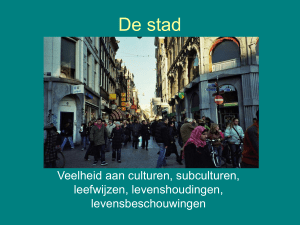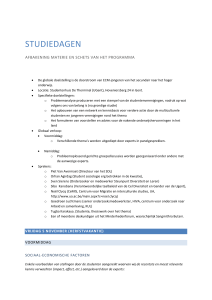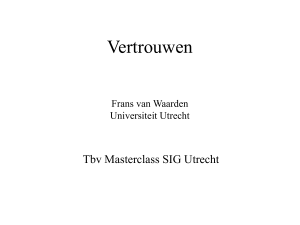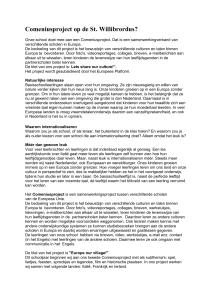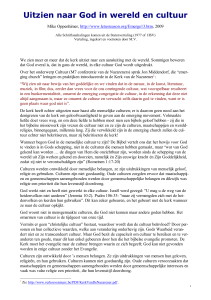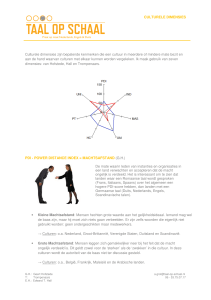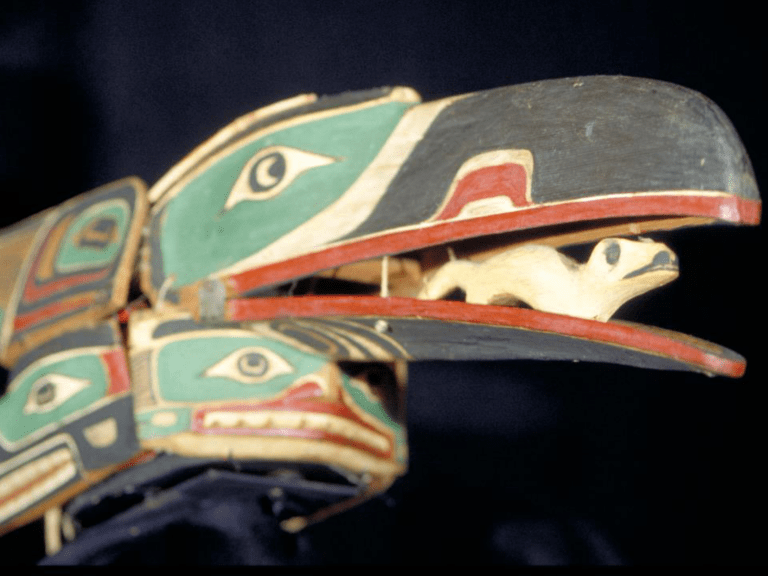
Culture Shock
Doelen:
1
Inzicht geven in het belang van kennis en begrip voor
traditionele culturen.
2
Kennismaking met Noord-Amerikaanse traditionele
volken en de diversiteit aan culturen.
3
Kennisoverdracht over kunst en cultuur van indiaanse
volken.
4
Inzicht geven in de relatie tussen de culturen en de
natuurlijke omgeving.
Antropologie is een gedragswetenschap. Het is de studie of leer
van de mens .
‘All living peoples belong to one species, Homo sapiens, for all
can successfully interbreed. Yet there is much that varies among
human populations. To an anthropologist, the term culture
generally refer to the customary ways of thinking and behaving
that are characteristic of a particular population or society. Culture,
therefore, is composed of such things as language, knowledge,
laws, religious beliefs, food preferences, music, work habits,
taboos, and so forth.’
Kennis en begrip voor traditionele culturen
Culturele antropologie beslist zelf niet 'hoe het moet', maar kan wel
nuttige, waardevolle inzichten verschaffen in hoe men binnen een
bepaalde cultuur omgaat met een specifiek probleem, waar dat
raakvlakken heeft met de omringende culturen, en hoe daartussen
gecommuniceerd zou kunnen worden.
Antropologen beschouwen dieren als integrale elementen in
menselijke samenlevingen en ecosystemen waarin de mens centraal
staat.
Relatie tussen de culturen en de natuurlijke omgeving
Dieren zijn economische rijkdommen, goederen en productiemiddelen voor menselijk gebruik.
Dieren zijn ook belangrijk in religie en rituelen, en dienen verder
als symbolen voor culturele normen en waarden die hun neerslag
vinden in de vorm van mythen, metaforen, kunst en literatuur.
Daarnaast vervullen dieren recreatieve, educatieve en socialiserende
rollen.
Cultuur blijkt net zo divers te zijn als natuur en in beide vormen
mensen en dieren een belangrijk onderdeel.
Noord-Amerikaanse traditionele volken
en de diversiteit aan culturen
9000 v Ch Volken die leven van de jacht verspreiden zich over
Noord- en Zuid-Amerika
1000 n Ch Vikingen bereiken Newfoundland
1492
Columbus bereikt West-Indië en Midden-Amerika
De ontdekking van Amerika door Columbus had grote gevolgen
voor de oorspronkelijke bewoners, die door hem Indianen werden
genoemd.
Hun gebieden werden grotendeels veroverd, veel volkeren
verdwenen voorgoed en hun talen en culturen werden grotendeels
verdrongen door Europese talen en het gedachtegoed van de
kolonisatoren. Toch zijn op veel plaatsen in Amerika, van Alaska tot
Chili, inheemse talen en gebruiken in stand gebleven.
De laatste decennia eisen de overgebleven indianen/First Nations
steeds duidelijker en vaker erkenning op voor hun eigen talen,
tradities en culturele identiteit.
Noord-Amerikaanse prehistorie
Archeologie is op zoek naar het verleden van beschavingen en is
dus onderdeel van culturele antropologie
Archeologen volgen de: Beringia Land Bridge Migration Theories
First Nations volgen hun eigen ontstaansverhalen
Veel dieren noemde men niet bij name
maar in termen van verwanten
de wolf :‘onze vader’
de beer: ‘vaders zuster’
de coyote: ‘neef, broer’
Coyote / Speel-yi
Honderden verschillende volken
We onderscheiden 10 Culturele gebieden
in Noord-Amerika
Een cultureel gebied is een
geografisch grondgebied
1
waarbinnen culturen
opmerkelijke overeenkomsten
vertonen
2
en er geen
overeenkomsten zijn met
omliggende culturen
Arctic
Aluet
Inuit
Yupik
The northern edge of North America from Alaska to Greenland is inhabited by numerous peoples
known collectively as 'Eskimos'. The 'First Nation' in Alaska refer to themselves as Alutiiq
(Aleuts), Yup'ik and Inupiaq, while the peoples in Canada and Greenland prefer the term Inuit.
The extreme arctic climate demanded a high level of adaptability and technical ingenuity to make
life in the cold surroundings possible. Items invented by these peoples include clothing made of
seal or caribou skin, waterproof outer garments made from entrails (anoraks), the leather-covered,
watertight canoe and the harpoon, the chief hunting weapon
Subartic
Athna
Northern Ojibwa
East Cree
Hare
Tlingit
Tanata
Dogrib
Tutchone
Yellowknives
De bewoners van de Subartics waren bijna geheel afhankelijk van de jacht en leefden daarom in
uiterst onzekere omstandigheden. Hongersnood was geen zeldzaamheid en deed zich voor als het
geluk van de jagers niet mee zat of als de voorraden waren verwoest door veelvraten, beren of
vijanden. Terwijl voor de meeste volkeren in het gebied de jacht op landdieren, aangevuld met
enige visvangst, de belangrijkste vorm van levensonderhoud was, waren de bewoners van de
kustgebieden aan de uiteinden vooral georiënteerd op de zee. Zij leefden hoofdzakelijk van vis,
zeezoogdieren en schaaldieren.
Pacific Northwest
Achomawi
Chemakum
Chukchansi
Clayoquot
Coast Salish
Cowichan
Haida
Hupa
Hesquiat
Karok
Klamath
Koskimo
Kwakiutl
Lummi
Makah
Nootka
Puget Sound
Salish
Quileute
Quinault
Shasta
Skokomish
Tolowa
Tututni
Willapa
Wiyot
Yurok
For the native inhabitants of the Northwest Coast at the time of Contact, the oceans, rivers, and
forests offered up plentiful fish and game. Even without agriculture other than some cultivation of
tobacco, the Northwest Coast Native Americans had more than enough food to support a dense
population. Because of the readily available sustenance and building materials for roomy houses
and seaworthy boats, the Native Americans had time to achieve an affluent and highly complex
society, much of it revolving around the custom of the potlatch, in which an individual’s prestige
and rank were determined by the quantities of material possessions he could give away.
Plateau Region
Cayuse
Chinookan
Kalispel
Klikitat
Kutenai
Nespelim
Nez Perce
Salish
Salishan
Spokane
Tlakluit
Umatilla
Walla Walla
Yakama
Villages, usually located along riverbanks, became the main political units, with headmen as leaders.
The earliest ancestors settled the area before 6000 B.C. In later years, people from the Great Plains
influenced Plateau inhabitants. The Nez Perces, for example, became excellent horse trainers and
breeders in Postcontact times.
Great Basin
Cahuilla
Chemehuevi
Comanche
Cupeño
Diegueño
Mono
Northern Paiute
Shoshonean
Washo
Because of the meager food supplies, people traveled for the most part in small family groups, with
minimal tribal identity and few community rites. The major groupings of peoples are Paiute, Ute and
Shoshoni, with various subdivisions and offshoots. By the 18th and 19th centuries, some bands had
become horse-mounted hunters on the Great Plains to the east.
New Southwest
Acoma
Apache
Cochiti Indians
Havasupai
Hopi
Hualapai
Isleta
Jemez
Jicarilla
Keresan
Laguna
Maricopa
Mohave
Navajo
Pima
Qahatika
Taos
Tewa
Tigua
Tohono O'Odham
Yuma
Yavapai
Zuñi
Two essential Indian life-styles developed in the region: agrarian and nomadic. Agriculture north of Mesoamerica
reached its highest level of development in the Southwest. The people of this culture area can further be
organized as follows: 1) the agrarian Pueblo peoples, including the western Pueblos (Hopi and Zuni), and the Rio
Grande Pueblos (Keres, Tewa, Tiwa, and Towa); 2) the agrarian Desert peoples (Hualapai, Havasupai, Yavapai,
Mojave, Yuma, Cocopa, Maricopa, Pima and Papago); 3) the Athapascans, late arrivals in the region from the
north (A.D. 800 to 1000), including the Apaches, nomads and raiders, as well as the Navajos, who eventually
adopted a pastoral life-style; and 4) the southwestern Texas and northern Mexico tribes, mostly nomadic hunters,
with some farmers among them.
California
Kato
Maidu
Miwok
Pomo
Wailaki
Wintun
Yokuts
Yuki
California is an amazing and varied region with mountains, valleys, deserts, and the Pacific
ocean coast. Native peoples lived in these regions for thousands of years before the Europeans
arrived a few hundred years ago. With all the diversity in geographic settings and languages,
California Indians still tended to share many cultural similarities. They all depended on acorns
as a staple food. They also relied on such foods as fish, deer, elk, antelope, chia, buckeye, and
epos root.
Great Plains
Arapaho
Arikara
Assiniboine
Atsina
Brule
Cheyenne
Chipewyan
Cree
Crow
Dakota
Hidatsa
Kainah
Mandan
Oglala
Osage
Oto
Piegan
Ponca
Quapaw
Sarsi
Siksika
Teton
Wichita
Yanktonai
This vast region is predominantly treeless grassland. The Great Plains culture area is unique in the
sense that the typical Indian subsistence pattern and related ways of life evolved long after Contact. It
was the advent of horses, brought to North America by whites - the first horses since the postPleistocene extinction of the native species - that made the new life on the Plains possible. With
increased mobility and prowess, former village and farming tribes of the river valleys became
nomadic hunters, especially of the buffalo. At the time of the Contact, it is believed that most of the
tribes were villagers and farmers, or at least semi-nomads, with settlements located especially along
the Missouri River.
Eastern Woodlands
Iroquois
Huron
Shawnee
Ojibwa
Algonquin
Pequot
Cherokee
Chocktaw
Chickasaw
Creek
Natchez
Montauk
Mi’kmaq
The Eastern Woodlands were moderate-climate regions roughly from the Atlantic to the Mississippi River and
included the Great Lakes. This huge area boasted ample rainfall, numerous lakes and rivers, and great forests. The rich
earth and forests from the Ohio River to the Gulf of Mexico comprised the southeastern part of the Eastern
Woodlands.
South east
Creek
Caddo
Cherokee
Alabama
Pame
Ais
Catawba
Bidai
Karankawa
Lipan
Solano
Guachichil
Apalachee
Over de oorspronkelijke bevolking van deze streek is zeer weinig bekend. Er leefden honderden
groepen jagers, vissers en verzamelaars. De rivieren, waarvan de afgezette grond een vruchtbare
sliblaag vormt, voorziet de ontelbare moerassen van het laagland permanent van water. De
moerasplanten leverden de plaatselijke volken waardevolle grondstoffen: het tegen rotting bestendige
hout van cipressen werd gebruikt als palen voor huizenbouw en om boomstamkano’s te maken terwijl
men van riet matten, manden, zeven, visnetten en een groot aantal gebruiksvoorwerpen maakte.
Welk klimaat heeft het gebied?
Beschrijf de natuurlijke omgeving
Welke dieren vind je er?
Welke eetbare planten zijn er te vinden?
Hoe kun je het best overleven in dit gebied?
Hoe groot was een groep bij elkaar wonende mensen?
Hoe leefde zo’n groep mensen?
Welke sociale structuur was er?
Welke voorwerpen waren er nodig om te overleven?
1 Landbouwers van het zuidwesten
2 Bizonjagers van de prairies
3 Vissers van de westkust
4 Jagers in het hoge noorden
5 Verzamelaars van het noordoosten

